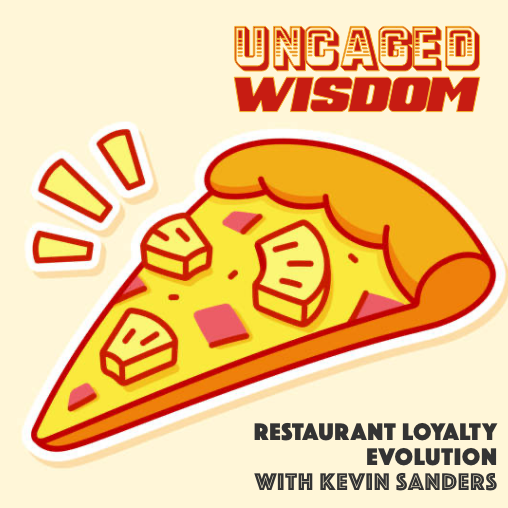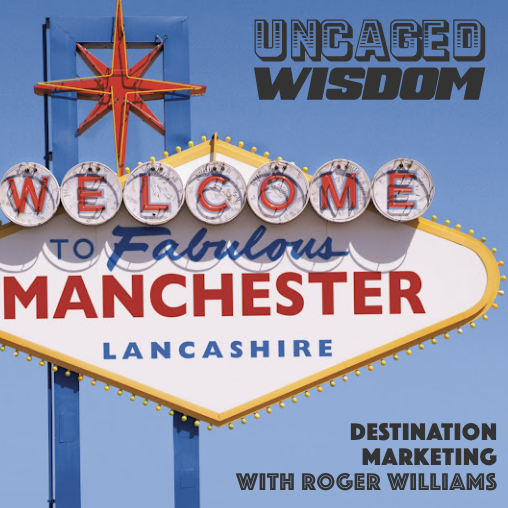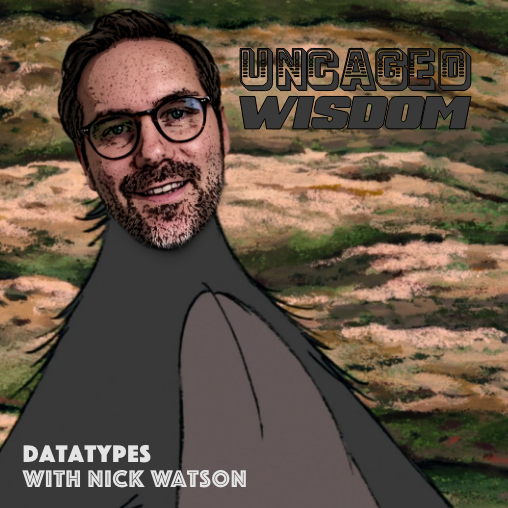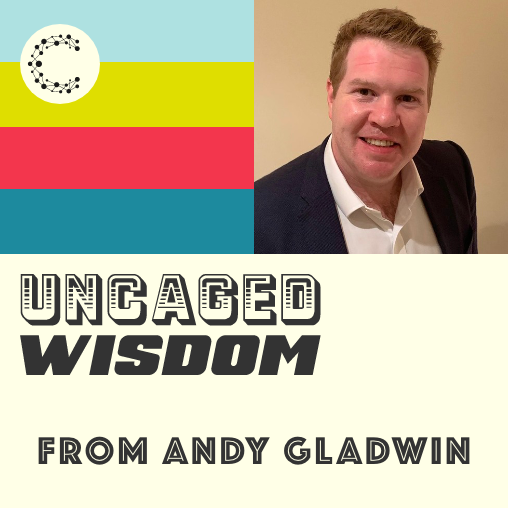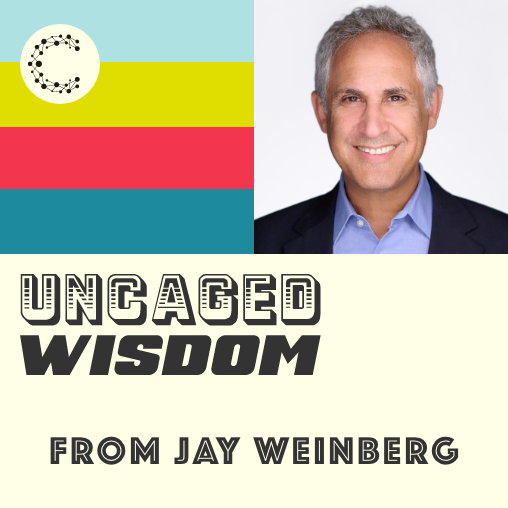Deep Dips: The Evolution of Restaurant Loyalty Programs w/ Kevin Sanders
- 0.5
- 1
- 1.25
- 1.5
- 1.75
- 2
Diva Renton-Roderix: Probably one of the big arguments I've had with my husband is over pineapple. He doesn't think it belongs on a pizza. So it's big debate in our house.
Kevin Sanders: Expand that man's perspective.
Speaker 1: Uncaged Wisdom. Deep dips. The podcast where we take a quick but deep dip into the world of relationship marketing.
Julian Bracey-Davis: Kevin Sanders, welcome back to Uncaged Wisdom, this time, Deep dips. It's lovely to see you again.
Kevin Sanders: Glad to be here.
Julian Bracey-Davis: Today we're going to be focusing more on the evolution of restaurant loyalty programs.
Speaker 1: Hey y'all. Just like the lone star state, when summer rolls around, torches deliver some serious heat. Settling for anything less would be about as welcome as a porcupine at newness colony.
Julian Bracey-Davis: Kevin, just to refresh people's memories, what are some of the different roles you've played in the restaurant space?
Kevin Sanders: I spent most of my career on the marketing side, both in consumer products goods as well as in restaurants. And I was head of marketing for a restaurant chain of Fast Casual chain here in the US, and also spent time on the digital ordering side in the marketing technology space and also doing some consulting in the restaurant space. So I probably spent about 13 or so years in the restaurant space and both on the supplier side now but also on the operator side.
Speaker 2: (singing) The worst vice is advice.
Julian Bracey-Davis: Kevin, to start off my latest feature, sympathy for the Devil's Advocate. So I'm going to read a statement to you and we're just going to roll with your reactions to it because it will help inform the rest of the conversation today. I'm going to set this up as this is from a restaurant marketer. I'm frustrated with my current loyalty efforts and I'm thinking of suspending the program. I'm just not getting back the return of investment we need.
Kevin Sanders: Well, it's certainly a sentiment that we hear a lot lately as folks start to really reevaluate the loyalty programs that they have in place. About five years ago, maybe a little bit longer, was really the time when everyone had to get a loyalty program. And so a lot of the restaurant chains out there were signing up for these loyalty programs and really not spending a whole lot of time at that point figuring out how to make these programs really work for the customers that are out there and really drive the behavior change that is critical to boost that ROI. And so what we find now is a lot of folks out there with very similar programs, these kind of earn and burn programs in the marketplace that are fairly ubiquitous. And as a result, consumers are not being moved to action by them anymore. And so what we find is these programs are not inexpensive to operate. From a franchise perspective, you've got not only the cost of the program, but you certainly have the cost of any discounts or comps that you're doing as part of the program and those can add up. And so if you're not getting behavior change, if you're not getting folks to do something that they weren't already planning to do, then it really is hard to make those programs a positive ROI if you really go back and look at those programs.
Julian Bracey-Davis: Before digitalization, what was the origins of loyalty to begin with. Before everything, you had a mobile wallet or a phone or you had ways to redeem things digitally.
Kevin Sanders: Yeah. It was the old paper punch cards. It was the cards you would get at the register that were the buy 10, get one free kind of example at your local coffee shop or your local sandwich shop. And every time you came in, you handed the card over and they punched it and gave you another punch. And that's where we got the name punch card from. And that was the initial programs. They were very much analog, so to speak as opposed to digital. And you had people losing them and they were destroyed or people were really not able to track them very well in terms of who was using them and why they were using them. So they had all the limitations of all the other paper products that you have in the marketplace now. And the reality was the big missing piece for the operators was all the customer data, really that understanding of who was using it, how often they were using it, what were they using it for? And being able to track and gather all of that customer data that could help inform how they operated the business moving forward.
Julian Bracey-Davis: Really, was it just working out how to get that paper world into the digital realm or was there anything that was added at that very first step or was it really just actually, we need to convert what we were doing in paper form and how we were giving out offers and then put that into some sort of digital environment?
Kevin Sanders: Yeah. That's exactly right. This corresponded with the growth of mobile apps, and suddenly you had this opportunity to create an app that could effectively digitize your punch card program. And so now you had the ability to capture some customer data with respect to who was using. But even at the time, we didn't really have all that sophisticated data capture and data management capabilities. So oftentimes, it was just a more convenient way for somebody to get their punches. And so the programs evolved from no program to these digital punch card or these non- digital punch card to effectively a digital punch card. But the programs themselves were effectively the same. They didn't really look at how the structure of the programs was organized in a way that would really optimize usage and frequency and spend and so forth. So they were a simply just a more convenient better version of what they already had.
Diva Renton-Roderix: I know that I still have stacks of cards that I don't use, that I'm still getting now from coffee shops in New York or donut shops and I just don't use them again. They don't know who I am.
Julian Bracey-Davis: In our world, is that what we class as first generation loyalty or as the first generality of these programs, the next step along?
Kevin Sanders: The program structure hasn't really changed. It was kind of this earn and burn program. So you were acquiring points and then you were able to redeem those points for some reward, whether that was a free food or some discounts. And really, when we talk about first gen versus next gen, it's really focused on the structure of the programs more so than the way the program is being redeemed and distributed in the marketplace. So first gen to me is a very transaction focused loyalty program. Again, it could be a punch card or points based programs, but the offers are generally generic, the promotions are generally generic, everybody gets the same one. Again, back when I was head of marketing, we ran a double points Tuesday and it was available to everybody every Tuesday and people that came in on Tuesday got double points. Whether they even knew it was double points Tuesday or not, they were getting those double points. And again, it was just a lack of sophistication in the technology that prevented us from getting very personalized or very specific in the way that we were delivering offers to individuals. And so for me, when I think about first generation, I'm thinking about this one size fits all program that is not really... is rewarding past behavior in terms of the things that you had already done more so than trying to drive future behavior.
Diva Renton-Roderix: I did want to call out the evolution of one of our clients as well, partly because the name of their program. So it's Baker's Delight and the program is called Dough Getters. Always a fan of a pun, so that's a winner. So they had stamp card for 20 years, they knew it was time to evolve and they wanted something simple, valuable, personal. And I like the way that they did a proof of concept, 16 weeks, eight bakeries, just in one region with the goal to increase visits and transaction spend, which they saw going from once a month to two per month. And then from the success of that, rolling that out across Australia and New Zealand. So that was a really nice, you've got the Burger King example, but this one actually not seeing that as a client now.
Kevin Sanders: Seen the same thing with inaudible and brands who have gone back and reinvented or reimagined their program based on better data, more effective use of that data to understand how to drive that behavior change throughout the program that is really critical to making that work. So both of those folks have evolved from, again, these transaction based first gen programs into what I would consider to be more second generation programs where they look at, how do we drive engagement, how do we drive participation, and ultimately, how do we drive personalization in these programs? That again, will really allow the customer to get more from the program in a way that it motivates and incentivizes them to perhaps do additional things that they weren't already intending to do. So whether that is coming in extra more often, driving that frequency or potentially if their spend or spend based programs, then spending more, using the program more often in different ways to, again, to make sure that behavior change is happening, which is really fundamental driving the ROI in these programs.
Julian Bracey-Davis: Do you remember any particular brand or structure that made that first leap into this more next generational approach?
Kevin Sanders: There's been several attempts to try to get this to work. So folks started adding gamification elements into the program. People started running these coalition programs which are how do you earn rewards through one brand and be able to maybe spend them in a different brand? I think back to the old plenty program and these other coalition programs where you're trying to create more value in the program to get people to engage with and use the program more because you're making the overall program different and ultimately more valuable to the customer. So there's been a number of different folks that have tried different things like that. Over time, some of them have been run effectively in terms of the structures and the programs, other ones, not so much. But I think where we find ourselves today is everybody has a loyalty program. And so simply having one is not enough. And so it's more around what are you doing with your program to not only make it something different and special, but also make it more highly engaging and then more personalized to deliver those more effective incentives to the consumer. And so I think what we've seen very recently in the last 12 to 24 months is people coming back and really needing to reevaluate what they're doing. They've either run the ROI in the program and realized that it's simply not effective the way they've had it structured, or they're simply recognizing that while people are signing up for the program, they're not using the program, they're not redeeming it, they're not collecting points. And if they're collecting points, not redeeming the points. And so you may have got them to successfully download the app or sign up for the program, but that's not enough. It's how you get those people to begin to use that program in a way, and as we've been talking about that really changes behavior, really gets them to do something different.
Julian Bracey-Davis: I'm going to still is directly from you, Kevin, because most of my education in this space and especially around loyalty in restaurants is from you. One of my favorite double Ps that you put together at the heart of next gen loyalty is participation and personalization. Maybe we could start off there?
Kevin Sanders: Yeah, you nailed it. I mean the idea that it needs to be participatory, so it needs to drive engagement with the way that you've set up the structure, whether that's using things like social sharing or referrals or I mentioned a lot of gamification is being used right now or other types of contests or being more effective at geo locating the program and being able to deliver rewards when folks are engaging directly in the store, so we're trying to drive traffic to the stores. There's a number of pieces that have been really around or within the programs all along that brands are now really starting to focus on to continue to drive that engagement with our customers. And then the next step becomes, how do we use the data that we're collecting and the information that we're collecting about our customers to really make those programs more personalized. So we're personalizing the offers, we're personalizing the promotions, perhaps making them exclusive to certain tiers, for example, or making the rewards themselves experiential. And so we're really taking that idea of the incentive or the motivator up to the next level by making it better match what the customer finds valuable. And that is where really, we begin to see the ROI take off on these programs. It's one thing to incentivize by using a point based system, and there's nothing wrong with point based system. I certainly don't want to pretend like those are not effective. I mean they can very well be effective, but beyond that, it's how are you making that program really address the specific way that that customer is engaging with your brand. And so the technology exists now and if you can get all of the pieces of your tech stack of your marketing tech stack working together, you can really leverage not only the data capture, but all of the different tools. I talk about getting your offers, your data and your loyalty all under the same umbrella because if you have all of those seamlessly integrated, you can get to the point where you're able to personalize offers in real time. And that's the holy grail that we're all trying to get to, is how do we deliver the right offer to the right person at the right moment? Because that's when you start to see that incredible response from your loyalty members in a way that can drive your business.
Diva Renton-Roderix: With these kind of programs, you can collect all sorts of different data points and therefore the opportunity to communicate in a much more personalized way, that's a lost opportunity if people aren't doing that, would you say?
Kevin Sanders: Absolutely. And so this idea of personalization, when you think about it, it's kind of a range. We can talk about personalizing communications in the sense of like, hello Diva, is something as simple as that through an email but what we're really trying to get to is being able to understand how in my example, Diva is engaging with my brand and then being able to deliver rewards and offers through these communication channels directly to that individual. So if Diva, for example, prefers text and Julian prefers email, part of the personalization from a messaging standpoint is to deliver the right message through the right channel for that customer so they'll engage with it more effectively. And then again, you get to the point where you're talking about how do we personalize offers, how do we drive the next best action or the next best experience for each of these guests, really all the way down to an in level, which again is now possible on platforms like the Cheetah platform, because again, if we can get all of those components working together, your offers, your messages and your data, now we're able to drive that engagement through the program in real time and scale. And that's where we're really trying to get it to.
Diva Renton-Roderix: I think it's particularly interesting with a family of brands, and we see this in CPG as well. It's understanding things about them that could show their interest in one of your other brands, not just the one that they are engaging with at the moment.
Kevin Sanders: Absolutely. And in the restaurant space, there's a number of what I'll call these portfolio brands. These larger parent brands that have a number of sub brands underneath them that they manage. And while you can manage those programs as individual separate loyalty programs, for example, the real power comes in being able to manage them up at the parent level, such that we can start to do this cross sell or cross optimization of a given customer throughout your portfolio not just at an individual brand. And so if you've got, for example, a sandwich brand and you're able to then tie that into an ice cream brand, for example, and really begin to look at that customer, not from an individual brand perspective, but from an overall organization or corporate perspective and how are we able to take that customer and really leverage them throughout our portfolio. And again, the Cheetah platform is unique and especially effective at managing up at that customer level up at that portfolio level and then be able to drive the executions down at the individual brand level.
Diva Renton-Roderix: Right. I like sandwiches and ice cream, but I may not know that they're both owned by the same brand as a consumer. I don't think you often realize that it's a family of brands.
Kevin Sanders: Right. And they don't even really need to. I mean, the fact that I'm engaging with a fast casual brand in the sandwich space, and next thing I know I'm getting promotions for another brand that is potentially in my same area that I could also frequent. We talk about share of stomach as a concept in the restaurant space. Like share of wallet is something other folks talk about, but to share a stomach, like we're all going to eat pretty much the same general meals during the day and so at least three times a day, I as a consumer, have a decision to make about what meal I'm going to consume. And so that gives the brands an opportunity to come back and say, how do I gain more of that share over the course of a month or a year. And how can I leverage the fact that I've got multiple brands in my portfolio potentially offering different eating occasions to really gain that share of stomach.
Diva Renton-Roderix: I love that. But everyone knows there's a different stomach for sweet food. There's an extra stomach.
Kevin Sanders: That's right.
Julian Bracey-Davis: You are a cow, Diva, you have multiple stomachs.
Diva Renton-Roderix: Yes. When it comes to dessert, yes.
Kevin Sanders: And it's important to keep those both stomachs full.
Julian Bracey-Davis: I don't know how many stomachs I've got because I'm a fan of ice cream sandwiches, so I've just taken two things and smudged them into one, so I'm a right mess.
Speaker 2: I am having a love affair with this ice cream sandwich. You want some? crosstalk.
Julian Bracey-Davis: Couple other things I just want to maybe isolate and talk about more, one connection between messaging and personalization.
Kevin Sanders: I look at the steps of the process as like the first one being integration. This idea that we need to get our data, our offers and our messages all seamlessly integrated and that's the integration step. And there's lots of brands in the marketplace right now, they're struggling with this integration step because they're trying to... they may have all of the pieces but they don't have them all working together. And that's the first step of this engagement process. You have to have them all working together. The second piece then becomes the orchestration. How do we begin to develop the audiences and the campaigns and really the automations that allow some of these things to work on their own so that you... not everything has to be a manual process just from an efficiency standpoint. And then third really becomes the automation. And if you get the integration and the orchestration together, that's how you get to this idea of personalization. So really increasing the relevancy of the communications and the offers, increasing the saliency of those, meaning that they're happening in real time so that you can engage that person directly when they're in that occasion. And then that's where we're really, again, we see this enormous boost in program performance when we can get to that level. So integration, getting all of your technologies to work together, whether they're all under the same umbrella or whether they're all just seamlessly integrated to the extent that that's possible in your tech stack, the orchestration, then developing the customer journeys, developing the campaigns, developing the programs so they can run in an autonomous way. And that's what will help get you to the point where you can then get to that real time personalization piece that is so critically important.
Julian Bracey-Davis: Well, using the data that's available, how are brands like the ones we're discussing trying to work out better offers for people? What can the data do to help predict and get more from users? That's a really messy question but hopefully you can see where I'm going.
Kevin Sanders: The biggest challenge in the restaurant space is there's lots of data streams. There's lots of various streams of data that restaurants are collecting about their customers, whether it's in store through the point of sale, whether it's through the mobile app, perhaps through an online or an off- premise ordering platform or third party delivery, or really all of these areas where you're able to capture engagement and customer data, it's getting all of those to work together so that you can form an idea of how an individual customer is engaging with your brand. That is the key to being able to then provide them with the offers and the communications that are likely to be most stimulating to them in a way that, again, drives that behavior change that we're hitting on all day to day. And so if your program is really just another me to program that you've set and forget five years ago, likely it's not an ROI positive program for you and you need to go back and take a look at that because you're probably over discounting to your existing customers and not getting that behavior change that you need to program effective.
Julian Bracey-Davis: We mentioned behavioral changes and that being at the heart of why we're doing all this. What are some of the behavioral changes that run through the thoughts of a restaurant marketer?
Kevin Sanders: If you ask any restaurant person what metric would they like to drive, they're going to stay frequency. The fact of matter is getting more folks to come into your restaurant more often is really what we want to happen. And so frequency is clearly number one. Spend is the second one. So not just come into the restaurant more often, but spend more when you do. And so again, we know that there's again, different levers that you can pull to try to drive that spend but creating a program around that is another important component of your loyalty platform. And beyond that, there's things like menu adoption. So how do we get folks for example, to explore our menu and try new items, or try inaudible or try different day parts. If we've got folks that are coming in primarily for lunch, how do we get them to come in for dinner? And so there's moving folks around the occasions and the menu driving trial, for example, of new items you're bringing out. Yeah, so that's another big one. And then margin really becomes the one on top of that. How do we start to drive our higher margin products? But those are more sophisticated metrics that we can look at. Primarily, we're looking at driving frequency and spender, probably the two most important ones.
Julian Bracey-Davis: I mentioned that Kevin, because when you and I discuss and us on the call, we talk about restaurant and restaurant loyalty. It always strikes me how relevant the lessons and the things that restaurant marketers are trying is relevant to other industries and other brands who are completely away who are sending retailers, example, I mean, there is quite a natural companionship there but there's so many things that could be applied. Even some of our finance brands and sporting brands that we work with, some of the things that the restaurant marketers are thinking about very, very good lessons to take across a different industry.
Kevin Sanders: That speaks to the idea of there's value in working with providers out there that work across various industries, because we know that different industries are in different places on the maturity curve here. CPG retail, they've been dealing with data and some of types of programs for many more years than the restaurants have. And so many of those folks have evolved to really push the boundaries of the way some of these programs are being communicated and being able to work with a company that works across all these different industries that can bring these best practices and bring these learnings from other industries is really, I think, valuable to restaurant brands today. And there's a lot of providers out in the marketplace that are very specific in the industries that they work in, but I think there's value to working with one that has a broader diversity of client basis and different industries they work with.
Diva Renton-Roderix: I have a tangent topic, don't know if it'll make the cup, but do you see what Domino's were doing last year, where they were buying up local restaurant vouchers essentially, and saying, you don't have to order through us but order through your local restaurants and giving vouchers. And I just thought that was... it's more around that values in supporting local community. I just thought that was a really interesting play. I saw it on TV and I was like, okay, that's a bold move.
Kevin Sanders: They're looking at different ways to try to drive engagement with their program and to drive engagement through adding value. And so if there's ways that brands can look at their program more broadly than just how do we create eight points for food, but looking at opportunities like that, and there's other brands out there that are doing the same types of things, because once you get people using your program regularly, once they see it as valuable and will use it more often, that's the gateway then to being able to deliver the programs that are really going to boost the performance of the program through some of the personalization tactics and tools that we've talked about. So Domino's has always been one of the brands that has not been afraid to try different things, to try to drive that engagement, then it's worked for them. I mean, simply look at the performance of their program. It works. And so another great example of this idea of next gen loyalty playing out in the marketplace.
Julian Bracey-Davis: Geez, brilliant tangent, because that's just spurred a quick idea. Domino's made the point, there's lots of third party companies who are fulfilling the orders between restaurant and then end stomach, as we can call it. We've helped brands try and fill the gap in the middle there because what they're missing is the direct information and relationship with a customer. And although they can't necessarily circumvent the third party, there are ways that they can put either a code or a reference or a coupon to get them to register so they know a little bit about the customers themselves. Just briefly, Kevin, what sort of thoughts have you had with the third party and how a brand can potentially regain the relationship that might otherwise be lost?
Kevin Sanders: Well, that's been a significant challenge in the marketplace because folks who are coming onto these third party marketplaces and using whether it's a Grubhub or Uber Eats or anything else like that, I mean, they own the customer. They can forward the order through, but there's no identifying information in that order that allows you to tie it back to a customer. And so the more orders go through those platforms, the less the brands themselves own those individual customers. Without getting too deep into it, we have a number of tools and techniques and programs that many of our brands and clients have used to try to regain those customers from the third party marketplaces. And again, we have some technologies that we're happy to discuss with folks who are interested in tackling that piece of it because it's real. And I think we're all realizing that it's not going to go away anytime soon. And so it has to be something where the brands retain or gain the customer data from those transactions to the best it's possible or move them onto their own platforms for reorders, because the more loyalty you're driving through those other apps, the less loyalty you're driving through your brand itself.
Julian Bracey-Davis: Own your data wherever possible to be the masters of your own destiny. That was quite poetic. I have nowhere by me. Just to do a quick recap, we today, thanks to Kevin and you your time. We've gone through the evolutionary steps of loyalty programs in the restaurant space from paper punch cards, right through to what we've discussed as next gen loyalty. Some of the things that just stuck out of my mind are the two Ps that make at the heart of next gen participation and personalization. And, Kevin, actually, I really, really like the steps that you made when thinking through setting this up. Integration, orchestration and automation that really combined into the personalization element of it. So we don't have to discuss any out. Again, just re- listen. Diva, take us home.
Diva Renton-Roderix: So ask you anything, we'll see if this gets to share of your stomach. Hot topic. Does pineapple belong on a pizza? Yes or no?
Kevin Sanders: No, absolutely. Pineapple belongs on a pizza.
Diva Renton-Roderix: Yes.
Kevin Sanders: There aren't many things that don't belong on a pizza. So-
Diva Renton-Roderix: Yeah, no judgment.
Kevin Sanders: Yeah. None whatsoever. Like all pizzas, it depends on the combinations that you put together to whether that is a how good that pizza can be. But your basic Hawaiian pizza is a fantastic collection of ingredients, including pineapple.
Julian Bracey-Davis: Kevin, thank you so much for your time. I know you're very busy, so I appreciate yours chatting to us.
Kevin Sanders: I'm happy to do it any time, enjoy the conversation.
Speaker 3: inaudible you have five minutes to complete your exam. Your time starts when I serve your dish. Understood?
Students: Yes, sir.
Speaker 3: Your dish is pineapple pizza.
Speaker 4: Are you( beep) crosstalk.
Speaker 1: Uncaged Wisdom is shot in front of a live audience. Mainly producer Jennifer Yaadein, hosted by Julian Bracey- Davis and Diva Renton- Roderix. Subscribe for even more deep dips, hashtag just the tip of the iceberg. Cheetah digital 2022 y'all.
DESCRIPTION
In this week's edition of Deep Dips, Kevin Sanders talks with Diva and Julian about the evolution of restaurant loyalty programs. Kevin shares what restaurant loyalty programs were like before everything became digital, why participation and personalization is the heart of next-gen loyalty, and thoughts on loyalty programs while third-party organizations have become a middle-man. Listen now for the evolution of restaurant loyalty programs, plus the pineapple on pizza debate is settled at last!
Today's Guests


